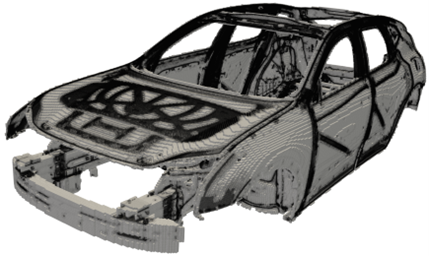Meshing is a major bottle neck in traditional methods for computational fluid dynamics (CFD) which typically require a boundary conforming mesh. An alternative is to use methods that couple the objects to a separate background mesh. The immersed boundary (IB) method is such a method that couples the objects to a background grid, typically Cartesian, using constraints. This also allows moving and deforming objects to be studied with very little computational overhead. The IB method is a general method that can be used not only in CFD, but also for computational electromagnetics, or any other problem modeled with partial differential equations. At FCC we primarily use the IB method for CFD, including fluid-structure interaction, conjugated heat transfer, and particle tracing problems. This technology is an important building block for industrial applications such as vehicle body assembly, surface treatment and coating processes, and digital twins and smart building energy solutions. Most CFD tools are restricted to expert users. By decreasing the pre-processing and meshing complexity our goal is to both simplify simulation setup and robustness for expert users, and to spread CFD to new fields and end-users closer to production. Our vision is to be a leader in the research of new methods and models for immersed boundaries and package them in tailored tools for simulation of challenging industrial processes.

At FCC the IB method is implemented in the state-of-the-art in-house fluid solver IBOFlow (Immersed Boundary Octree Flow solver). In IBOFlow all objects are IBs, and the code is designed with respect to the IB method to optimize usability, performance, and memory usage. In the incompressible finite-volume based fluid flow solver the Navier-Stokes’ equations are coupled with the SIMPLE-C method and the variables are stored co-located. The governing equations are discretized on a Cartesian octree grid that can be dynamically refined and coarsened, enabling grid refinement to follow moving IBs. No boundary fitted grid is required and the meshing procedure is fully automatic. Turbulence is generally handled in IBOFlow by the Spalart-Allmaras or k-omega SST turbulence models with stress-based wall model treatment.

